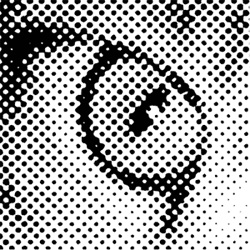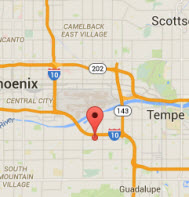Learn How To Screen Print With Catspit Productions, LLC
Halftone Printing
Halftone Printing: General Recommendations & Guidelines
This aspect of screen printing can get technical and become laden with unfamiliar terminology. Yet there is some very basic information we can relay without becoming too technical. However, a thorough knowledge of screen printing and art set up is needed to fully grasp this information in order to achieve good results. It is recommended that you begin by reading many of the other articles on this website before continuing further.
Here are some general recommendations for working with halftones in screen printing. A fundamental necessity for great halftones is high quality film positives. It is an absolute must that the halftone dots are completely opaque.
Some points to remember:
- Large areas of the same color or dark areas will be the most likely to cause moir� patterns
- Use stable, metal frames of the same dimensions
- Use the same mesh on all of the screens
- Stretch all of the frames with the same procedure and tension
- Use very sharp, clean edged squeegees
- Try to use high viscosity inks with halftones


Graphic Work:
- Ink Type
- Solvent Based
- UV
- Water Based
- Halftone lpi
- Up to 120 dots/inch
- Up to 150 dots/inch
- Up to 120 dots/inch
- Mesh Threads/inch
- 305 - 420
- 355 - 460
- 355 - 460
- Thread Diameter
- 27, 31 and 34
- 27, 31 and 34
- 27 and 31
Tee Shirt Printing:
- Ink Type
- Pigment
- Plastisol
- Halftone lpi
- Up to 60 dots/inch
- Up to 90 dots/inch
- Mesh Threads/inch
- 156 - 230
- 230 - 355
- Thread Diameter
- 64, 55, 40 and 48
- 48, 40, 38, and 31
When making film, angling controls the moir� pattern created between the halftone lines of each individual color film separation. Halftone angling may be given in two ways:
- Within 90 degrees for rulings with two axes of symmetry such as checkerboard & dot rulings. This would be for round dots or squared dot patterns.
- Within 180 degrees for rulings with one axis of symmetry such as bead rulings. This would be for elliptical dot patterns.
Colors like cyan, magenta and black should be at an angle of 30 degrees from one another. Yellow, being a weaker color, can be set at a 15 degree angle from a darker color.
For images with high black content and deep tones:
- Color
- Yellow
- Magenta
- Cyan
- Black
- Within 90 Degrees
- 0 degrees
- 15 degrees
- 75 degrees
- 45 degrees
- Within 180 Degrees
- 0 degrees
- 15 degrees
- 75 degrees
- 135 degrees
For images where yellow and magenta are dominant like in skin tones or orange colors:
- Color
- Yellow
- Magenta
- Cyan
- Black
- Within 90 Degrees
- 0 degrees
- 45 degrees
- 75 degrees
- 15 degrees
- Within 180 Degrees
- 0 degrees
- 135 degrees
- 75 degrees
- 15 degrees
For images where yellow and cyan are dominant like in greens and water or aqua colors:
- Color
- Yellow
- Magenta
- Cyan
- Black
- Within 90 Degrees
- 0 degrees
- 15 degrees
- 45 degrees
- 75 degrees
- Within 180 Degrees
- 0 degrees
- 75 degrees
- 135 degrees
- 15 degrees
The most dominant colors should be at 45 degrees, (within 90 degrees), and at 135 degrees, (within 180 degrees). For a one color halftone the angles should be at 45 degrees for both dispositions of 90 and 180 degrees.
Be careful not to over flood the halftone screen on the flood stroke. Printing four color process, duo tones, and one color halftones on a manual textile screen printing press can be challenging. Halftones are most often done on automatic machines due to their consistency and accuracy. Manually printing halftones takes the skilled hands of an experienced screen printer.
These are general guidelines. It is always recommended to check with your ink and mesh vendors as well as your graphic artist for specific instructions on creating film and screens for screen printing halftones. If you are unsure about the information or terminology used here, please consult a qualified graphic artist when creating your artwork and screens.


 Screenprinting Equipment From Catspit Productions
Screenprinting Equipment From Catspit Productions


